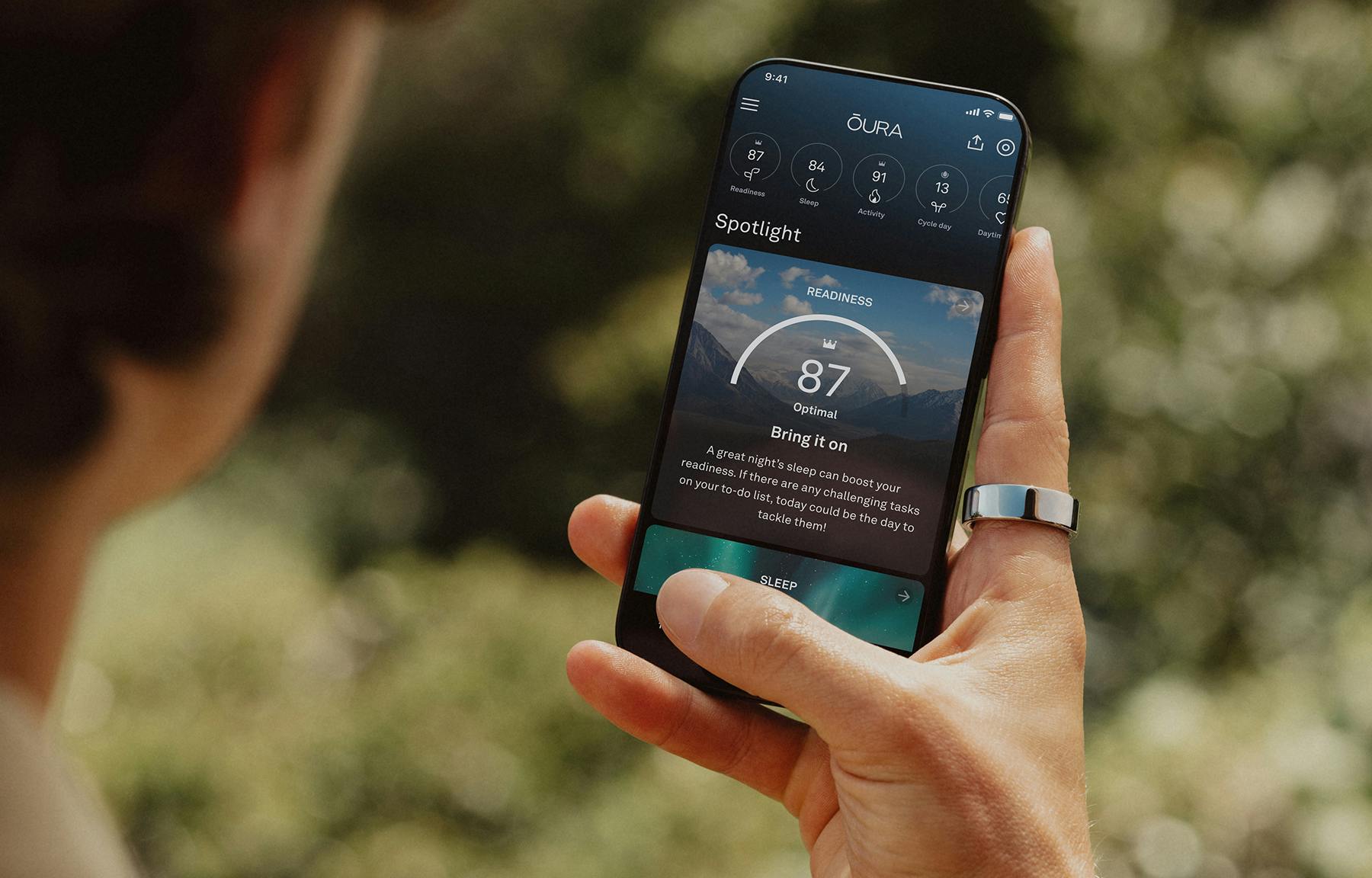Gestational diabetes—or high glucose levels during pregnancy—affects up to 15% of women globally. Whether you’ve just received a diagnosis or are proactively monitoring your health, managing your glucose levels during pregnancy is critical for you and your baby.
Below, learn about gestational diabetes and how Oura can help you manage this condition.
| Member Tip: Oura’s newly updated Pregnancy Insights feature supports mothers-to-be with data-backed insights, support, and education throughout every phase of their journey. |
What Is Gestational Diabetes?
Gestational diabetes mellitus (GDM) is a type of diabetes that develops during pregnancy, typically around week 24 of pregnancy, when your body becomes less sensitive to insulin, the hormone responsible for regulating blood sugar.
 During pregnancy, the placenta produces hormones that help your baby grow. However, some of these hormones—such as human placental lactogen (hPL), cortisol, and growth hormone—can interfere with how your body uses insulin. As a result, your cells become more insulin resistant, meaning glucose builds up in your bloodstream rather than being used for energy.
During pregnancy, the placenta produces hormones that help your baby grow. However, some of these hormones—such as human placental lactogen (hPL), cortisol, and growth hormone—can interfere with how your body uses insulin. As a result, your cells become more insulin resistant, meaning glucose builds up in your bloodstream rather than being used for energy.
For most people, the pancreas can handle the demands that hormones from pregnancy put on it by producing more insulin. But if your body can’t keep up with the increased demand for insulin, blood sugar levels rise, leading to gestational diabetes.
Left unmanaged, gestational diabetes can increase the risk of complications such as:
- High birth weight of the baby (macrosomia)
- Premature birth (birth before 37 weeks)
- Preeclampsia (high blood pressure in pregnancy with other complications)
- Cesarean delivery
- Low blood sugar in the newborn
- Higher lifetime risk of type 2 diabetes for both mother and baby
However, when it’s managed effectively and blood sugars are kept in a normal range, it usually doesn’t have any consequences for the mother or baby.
What Are the Early Signs of Gestational Diabetes?
Gestational diabetes usually doesn’t cause any noticeable symptoms, which is why it’s often only diagnosed after the glucose tolerance test (routinely performed between weeks 24 and 28 of pregnancy).
However, some individuals may experience early signs and symptoms before diagnosis if their blood sugars are very high.
Possible early symptoms of gestational diabetes include:
- Increased thirst: Feeling unusually thirsty even after drinking fluids.
- Frequent urination: Needing to urinate more often, especially at night.
- Fatigue: Feeling more tired than expected, even for early pregnancy.
- Blurred vision: Temporary vision changes due to fluctuating blood sugar levels.
- Dry mouth: A persistent feeling of dryness in the mouth.
- Increased hunger: Cravings or feeling hungry shortly after eating.
It’s important to note that these symptoms are not exclusive to gestational diabetes and can overlap with normal pregnancy changes. If you’re experiencing any of them persistently, consult your healthcare provider.
READ MORE: Pregnancy Symptoms by Trimester: What’s Normal—and What Might Be a Red Flag
Can You Prevent Gestational Diabetes?
Gestational diabetes is not always preventable, especially if you have risk factors like a family history of diabetes, PCOS, or advanced maternal age. However, there are steps you can take to lower your risk (more on this below).
The causes of gestational diabetes are complex, and researchers aren’t certain why some women experience it and others don’t. However, there are established risk factors:
- Having a pre-pregnancy weight that is overweight or obese
- Sedentary lifestyle
- Family history of type 2 diabetes or gestational diabetes
- Previous pregnancy with gestational diabetes
- Polycystic ovary syndrome (PCOS)
- Being over age 35 at the time of pregnancy
- Having previously given birth to a baby over 9 pounds (4.1 kg)
- Certain ethnic backgrounds, including African American, Hispanic, Native American, and Asian
Below, learn expert tips to manage gestational diabetes during pregnancy and how Oura can help.
How to Manage Gestational Diabetes
Most people with gestational diabetes can manage their blood sugar through diet, exercise, and close monitoring alone—but if levels remain consistently high, your provider may recommend insulin or oral medications. Treatment decisions depend on your individual glucose patterns and how far along you are in pregnancy. Medication decisions are between you and your trusted provider.
Whether you have been diagnosed with gestational diabetes and are monitoring your sugar to keep it in range, or you’re trying to prevent gestational diabetes, the following tips can help keep your blood glucose stable in pregnancy:
1. Track Your Glucose Levels

Tracking your glucose levels helps you understand how your body responds to different foods, meal timing, and physical activity. This allows you to identify patterns—like post-meal spikes or overnight lows—that can inform adjustments to your diet and daily habits.
According to the American Diabetes Association, typical glucose targets for most individuals with gestational diabetes are:
- Before a meal (fasting): 95 mg/dL or less
- 1 hour after a meal: 140 mg/dL or less
- 2 hours after a meal: 120 mg/dL or less
2. Follow a Glucose-Friendly Diet
If you’re wondering how to control your glucose levels during pregnancy, making simple tweaks to your diet can play a huge part. When planning your meals, focus on:
- Complex carbohydrates like whole grains, legumes, and vegetables for steady energy release. Combine any carbohydrates with proteins, fats, and high fiber to keep glucose absorption slow and steady.
- Lean proteins at each meal to support satiety and blood sugar balance
- Healthy fats like avocado, nuts, seeds, and olive oil
- High-fiber foods to slow glucose absorption and improve insulin response
Spacing your meals and snacks evenly throughout the day can also prevent large spikes or drops in blood sugar.
READ MORE: The Essential Guide to Eating for Metabolic Health

3. Stay Active
Physical activity improves insulin sensitivity and helps lower post-meal blood glucose. Gentle movement—even short walks after meals—can make a measurable difference. Aim for:
- At least 30 minutes of moderate-intensity movement most days, with your provider’s approval, aiming for at least 150 minutes each week
- Activities like walking, prenatal yoga, or swimming that feel sustainable and safe throughout pregnancy
READ MORE: Prenatal exercise blog
4. Prioritize Sleep & Stress Management
Poor sleep and high stress levels can negatively affect blood sugar regulation in pregnancy. Support your body by getting 7–9 hours of quality sleep each night. If you’re struggling with pregnancy insomnia, try to take naps during the day or make time for restorative moments whenever you can.
Pregnancy can be a stress-inducing time for many mothers, so make time for relaxation techniques like breathing exercises, meditation, or prenatal massage.
| Member Tip: Access guided meditation and breathing exercises within Explore content on the Oura App. |
READ MORE: How to Sleep Better During Pregnancy
5. Get Regular Prenatal Checkups

If you’ve been diagnosed with gestational diabetes, your provider will likely schedule additional check-ins to track your blood sugar levels, assess fetal growth, and adjust your care plan as needed. These appointments play a critical role in catching potential complications early and ensuring the best possible outcomes.
Looking Ahead
A gestational diabetes diagnosis can feel overwhelming, but with the right support, it’s entirely manageable. Once your pregnancy is over, the habits you have built around healthy eating and activity should be continued. However, it’s important to remember that people with gestational diabetes have a higher risk of later developing type 2 diabetes, and your doctor will likely want to screen you more frequently for diabetes.
In the long term, the habits you build now to care for your blood glucose may prevent future Type 2 diabetes, and will serve as a role model for healthy living for your child, creating a strong foundation for the future.











